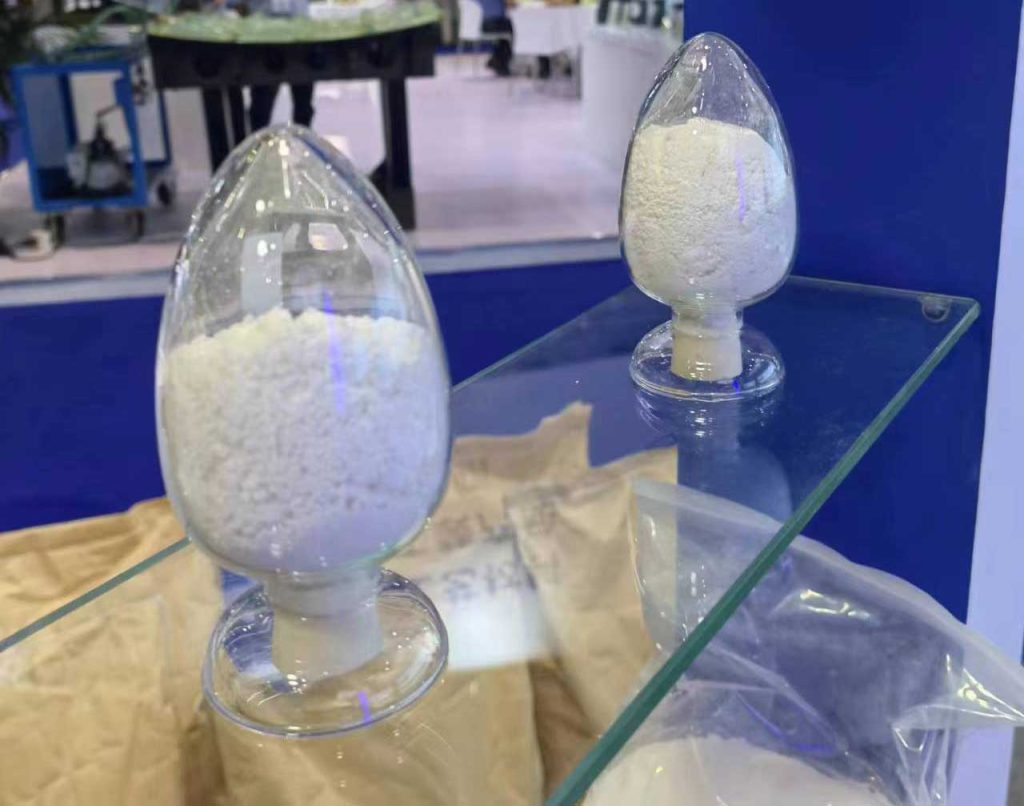Sorbitan Monostearate
What Is Sorbitan Monostearate?
Derived from the reaction between sorbitol and stearic acid, sorbitan monostearate, also known as Span 60, holds the European food additive number E491. Its primary role as an emulsifier is pivotal, ensuring the harmonious mixing of water and oils, a fundamental process in countless applications. This is formed by combining sorbitol and stearic acid. Often referred to as a synthetic wax due to its unique properties, it serves a multitude of purposes that range from medicinal to culinary.
Chemically characterized as a non-ionic surfactant, this compound possesses emulsifying, dispersing, and wetting capabilities. Its origin lies in the partial esterification of stearic acid with sorbitol and its mono- and dianhydrides. This synthesis gives rise to a compound with remarkable versatility, adaptable to various industries.
Sorbitan monostearate takes on the role of a diluent in color additive mixtures. It can also shine as an emulsifier that lends its efficacy to an array of food products. One of its most prevalent application of sorbitan monostearate in yeast, where it contributes to texture enhancement and shelf-life extension. As a synthetic ester, it plays a pivotal role in the creation of food and healthcare products, functioning as a surfactant with impressive emulsifying properties. Its hydrophobic, nonionic nature makes it an ideal candidate for roles such as emulsification, stabilization, and defoaming in various products. Notably, it aids in binding flavors, regulating viscosity, and safeguarding components against heat-induced degradation.
Names and Identifiers
One common synonym is Span 60. Drewsorb 60 is another alternate name because of its association with the sorbitol derivative and stearic acid. Montane 60 serves as a synonym that underscores its role and chemical composition. Sorbitan monostearate can be referred to as stearic acid, monoester with sorbitan or polyoxyethylene sorbitan monostearate, providing a precise description of its composition and structure.
The chemical formula of sorbitan monostearate, C24H46O6, is a concise representation of the elemental composition and arrangement within the compound. This formula elucidates the specific atoms that constitute sorbitan monostearate, namely 24 carbon (C) atoms, 46 hydrogen (H) atoms, and 6 oxygen (O) atoms. Central to the identification of sorbitan monostearate is its Chemical Abstracts Service (CAS) number, which is 1338-41-6. Sorbitan Monostearate CAS number acts as a digital fingerprint, ensuring accuracy and precision in its classification and usage.
If you are asking what is sorbitan monostearate E number, this is E491. This classification is part of the European food additive numbering system. E491 signifies its role as an additive in the realm of thickeners, indicating its capability to influence the viscosity and texture of various products.
Chemical and Physical Properties
The molecular weight of sorbitan monostearate stands at 430.6 g/mol, encapsulating the sum of its atomic masses. This numerical value reflects the compound’s complexity and provides insight into its overall size and structure. Presenting itself as a dry powder, sorbitan monostearate manifests as a white to tan waxy solid, establishing its distinct physical form.
An unmistakable trait of sorbitan monostearate is its slight odor, which although faint, contributes to its sensory profile. While it may not be the primary feature, this olfactory aspect can influence product experiences, particularly in formulations where aromas play a role. Additionally, its bland taste ensures that it remains neutral in flavor, allowing it to harmonize seamlessly with a range of applications.
Sorbitan monostearate’s melting point, ranging between 49-65 °C, dictates its transition from solid to liquid under specific conditions. This characteristic is pivotal in applications where controlled temperature changes are involved. In terms of solubility, the compound dissolves in ethanol, isopropanol, mineral oil, and vegetable oil, highlighting its affinity for various solvents. However, its insolubility in water and propylene glycol sets the stage for its specific applications that require separation from aqueous solutions.
With a density of 1.0 @ 25 °C, sorbitan monostearate’s mass per unit volume is established. This property has implications for its incorporation into formulations where density considerations are crucial. On the other hand, when subjected to decomposition through heat, the compound emits acrid smoke and irritating fumes. This aspect underscores the need for proper handling and awareness of its response to elevated temperatures.
How Is Sorbitan Monostearate Made?
Sorbitan monostearate emerges through a precise process known as esterification. This method involves the harmonious fusion of sorbitol, a derivative of sugar alcohol, with stearic acid, a saturated fatty acid. As these two components react, new chemical bonds form, leading to the creation of sorbitan monostearate. This synthesis showcases the art of controlled chemical reactions, where the amalgamation of sorbitol and stearic acid transforms into a compound with versatile applications.
What is sorbitan monostearate synthesis? It begins with the careful selection of top-quality sorbitol and stearic acid. These raw materials are subjected to controlled conditions, often with the aid of catalysts, to facilitate the reaction. The reaction leads to the formation of ester bonds, intricately connecting the molecules and resulting in the final product. This manufacturing process unveils the intricate chemistry behind sorbitan monostearate’s creation, emphasizing its importance in delivering functionalities that span across food, cosmetics, pharmaceuticals, and more.
Sorbitol
Sorbitol belongs to the category of sugar alcohols, a group of compounds that possess both alcohol and carbohydrate characteristics. It’s derived from glucose, a simple sugar, through a process known as hydrogenation. This structural transformation results in a compound with a sweet taste, albeit not as intense as that of regular sugars. Classified as a type of carbohydrate, sorbitol shares some traits with sugars but exhibits distinct properties due to its altered molecular structure.
In the context of sorbitan monostearate, sorbitol’s role as a key component is underscored by its contribution to the formation of the compound. Through esterification, a chemical reaction involving the interaction of sorbitol with stearic acid, sorbitol becomes an integral part of the resulting synthetic ester – sorbitan monostearate. This process involves the rearrangement of molecular bonds, leading to the creation of a compound that combines the properties of its constituent parts.
Stearic Acid
Stearic acid is a long-chain saturated fatty acid that occurs naturally in an array of animal and plant fats. It is most commonly sourced from coconut oil or palm oil, both rich sources of this fatty acid. Its presence in these natural fats underscores its relevance in both biological systems and industrial applications.
With an 18-carbon chain, stearic acid is classified as a saturated fatty acid. This structural characteristic is crucial, as it signifies that all carbon-carbon bonds within the chain are single bonds, making it “saturated” with hydrogen atoms. This structural aspect accounts for stearic acid’s physical properties and behavior within compounds like sorbitan monostearate.
Uses
Sorbitan monostearate in yeast acts as an emulsifier and stabilizer that improves the texture and consistency of yeast-based products. Similarly, in the creation of ice cream, sorbitan monostearate enhances the creaminess and stability of the mixture, resulting in a smoother and more enjoyable dessert. The compound’s attributes also extend to margarine and whipping cream, where its emulsifying properties ensure even distribution of ingredients and contribute to the desired texture.
The applications of monostearate sorbitan extend to the realm of baking as well. In the production of bread and cake, it acts as an emulsifier that aids in creating a homogenous mixture, leading to improved volume and texture in the final baked goods. The compound’s utility doesn’t stop there; even in the world of chocolate production, monostearate sorbitan plays a role. It serves as an emulsifier in chocolate formulations, ensuring the smooth and consistent blending of ingredients while preventing separation during storage.
Is Sorbitan Monostearate Safe to Eat?
For most individuals, monostearate sorbitan exhibits almost no side effects when consumed within established limits. It’s worth noting that adverse reactions are exceedingly rare. As an emulsifier and stabilizer, it is primarily used in small quantities, contributing to the overall safety of products.
Sorbitan monostearate’s safety has been scrutinized by regulatory agencies around the world. Authorities such as the U.S. Food and Drug Administration (FDA) and the European Food Safety Authority (EFSA) have assessed its use and granted it Generally Recognized as Safe (GRAS) status and approval as a food additive, respectively.
Is Sorbitan Monostearate Vegan?
The question of whether monostearate sorbitan is vegan revolves around the origin of its components, particularly sorbitol and stearic acid. Sorbitol, a derivative of corn, is inherently vegan, setting a solid foundation for the compound’s potential vegan status. However, the determination of whether sorbitan monostearate is truly vegan hinges on the source of stearic acid utilized during its production.
Stearic acid, as a component of sorbitan monostearate, plays a crucial role in shaping the compound’s nature. Its origin is the determining factor in the compound’s vegan classification. If the stearic acid is sourced from plant-derived oils, such as coconut or palm oil, the resulting sorbitan monostearate remains vegan-friendly. Plant-based stearic acid aligns with the ethos of veganism, as it avoids animal-derived sources.
Sorbitan Monostearate is a good emulsifier which the CAS number is 1338-41-6 . Sorbitan Monolaurate could use for lubricant and food and other industrial sector.We sincerely look forward to your cooperation and provide you with better product quality and services.


